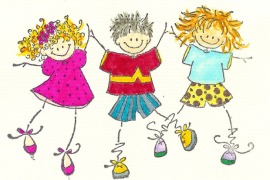As a speech pathologist who works with children (from 18 months of age right up to 18 years of age), it is apparent that the speech pathology profession is somewhat misunderstood. It is generally unclear amongst the broader community and even some related professions what it is we actually do. There has been many a time where I’ve been asked at the family BBQ or at the pub with friends “so, what do you do with yourself?” Instead of being proud to answer confidently about a profession I am passionate about, there is a sense of hesitation and predictability as to what the reaction will be to my response.
“I’m a speech Pathologist” I say….and then I pause for the range of retorts.
Great Aunt Betty speaks in a slow and exaggerated how now brown cow type manner while enunciating “Ooh I’d better watch how I speak then around you dear”.
Cousin Bill starts talking to me with a fake s-s-s-stutter. Hilarious!
And what’s his name at the pub slurs, “I reckon I’ll need some help with my talking after all these beers!”
So, what is a speech pathologist?
And what’s the difference between a speech pathologist and a speech therapist, or even a speech and drama teacher? Let’s start from the beginning.
Speech Pathologists used to be referred to as Speech Therapists but more recently the term ‘pathologist’ has replaced ‘therapist’ which causes some confusion. Simply though, this change in title does not change what we do as a profession. The term therapist refers to the therapy or intervention that is provided to an individual. It was felt though that this term did not cover the diagnostic side of the work we do. Therefore, ‘pathologist’ was introduced as a replacement, as it acknowledges that we are qualified by our training and experience to identify, assess and provide treatment for disorders of communication.
So we’ve covered the technicalities of our title, but the question of what we do still remains. If you type into Google “what is a speech pathologist?” a link to the Speech Pathology Australia (SPA) website comes up. SPA is the national peak body for the profession in Australia. They state that “speech pathologist’s study, diagnose and treat communication disorders, including difficulties with speech, language, swallowing, fluency and voice”. That’s all very well, but some terms require a base understanding, so I’m going to cover speech, language and fluency.
What is “Speech”?
The term “speech” represents the vocalised activity we as humans use to communicate. The term encompasses several components. Phonation, which is the sound we make when we talk; articulation, the production of speech made by our oral structures (tongue, lips, teeth, palate) in order to produce words. Then there’s the tone or resonance which provides us with a unique voice quality. Finally, fluency refers to the synchronization of all these components to complete the act of speech. If fluency is out of whack, then speech can appear bumpy or distorted and the flow of speech is disrupted. This is what we call stuttering or stammering and a speech pathologist is the best person to see for this problem.
It must be noted that all children make predictable pronunciation errors when they are learning to talk, but at times, these errors do not improve on their own. A speech pathologist is able to assist a child who has speech or clarity difficulties when they talk. In addition to stuttering, this may include articulation or phonological disorders, as well as more complex problems such as Childhood Apraxia of Speech (CAS) where the brain has difficulty coordinating the articulators that make the speech sounds. Articulation refers to the sounds we use in speech and how we produce them. A common articulation error is a ‘lisp’ where the /s/ sound is pronounced as a /th/ sound. Intervention would focus on learning how to produce the /s/ sound correctly and incorporating it into speech. Phonological therapy targets patterns of sound errors that continue past an appropriate age. For example, the /pl/ in “plane” may be reduced to “pane”, “bus” is pronounced as “bub”, or “dog” is pronounced as “gog”. Both articulation and phonological therapy involves working on specific speech sounds within single words, sentences and conversation and to then generalise across all contexts.
This is where I want to clarify the difference between a speech pathologist and a speech and drama teacher, as sometimes this in itself can cause confusion. A speech and drama teacher work with those who have appropriate speech, but are learning to build confidence and performance skills including public speaking and acting. Speech Pathologists work in the area of speech sound disorders which may affect general communication.
The Art of Communication
Speech is an important component of communication, but in order to communicate effectively using words or vocalisations, our language system needs to be functioning properly. When I say “language”, I don’t mean different languages such as French or Italian. I’m referring to our ability to understand speech (receptive language = input) and express ourselves (expressive language = output) effectively. If a child’s language is not developing at an age appropriate rate, this may result in learning difficulties which may include speech development. Let’s be a little more specific.
Receptive language involves listening to and understanding words and their meanings (vocabulary), being able to understand and follow directions and instructions, understanding concepts (such as before/after, on/off, what, who, where etc.), understanding and interpreting questions, recalling and retaining information, developing short term and long term memory and developing auditory processing skills (not hearing but processing of heard sounds and instructions for understanding). As receptive language develops, a child learns to interpret more complex forms of language grammatically, where further concepts need to be understood. For example, the cat was chased by the dog or James was a policeman before he became an actor.
Receptive language is also very important socially, where children learn how to interpret particular social situations correctly and understand the rules of interacting. This is where gesture can play a major role such as knowing what it means when someone waves, hand gestures that mean “come here”, thumbs up for “good job”, and nodding and shaking head for yes and no, to name a few. Receptive language is imperative for the development of expressive language so that a child learns to communicate with purpose and meaning.
That brings us to expressive language which represents a person’s ability to express themselves using gesture and facial expressions, using speech in single words, and the grammatical combination of spoken words within sentences and conversation. When talking, expressive language involves being able to functionally use words appropriately, requesting, questioning and commenting, giving instructions, asking and answering questions, structuring sentences that are grammatically correct (for example “There are two mouses” vs. “there are two mice” or “me iPad” vs. “I want the iPad” etc.), formulating and conveying thoughts, telling stories, and following the social rules of conversation such as staying on topic, using eye contact and knowing how to respond. It can be frustrating for a child if they unable to express themselves effectively (or clearly = speech related) and that’s where speech pathology intervention can be so important to get them back on track.
Very closely related to language is learning. If a child does not have the skills to understand or express themselves appropriately, they are likely to have difficulties learning effectively. As a child develops and enters the preschool and school aged years, the literacy component of learning swings into full flight. Literacy essentially covers reading, writing and spelling and is the basis for academic learning and success as children grow.
Reading comes so naturally to some, but there are many fundamentals to becoming a good reader. Reading involves learning several processes such as sound and letter recognition, blending and segmenting of sounds, word recognition, and comprehension or understanding. In addition to understanding the rules of reading words, the ability to understand what is being read takes a lot of practice, especially as a child gets older and text becomes more complex. Speech Pathologists are trained to identify and design programs that assist in learning the reading process, including comprehension which is a major component of receptive language.
Writing is an expressive form of language used to convey thoughts and stories on paper or other devices. In order to understand how to write, a child needs to understand the basics of language, especially oral language. They need to be able to express their thoughts, feelings and ideas coherently in a verbal manner in order to do the same within their writing in a grammatically correct way. If they have difficulties with one form, then the other will be just as difficult and speech pathologists work closely with students who require support. Speech Pathologists aim to teach students that there is purpose behind what they are learning which assists with motivation and ongoing academic success.
So there you have it. Communication is such a broad term and is such an essential part of everyday human life. Whether it’s speech, language, academics or a combination of all, Speech Pathologists are trained professionals, there to help children of all ages develop their range of communication abilities.


